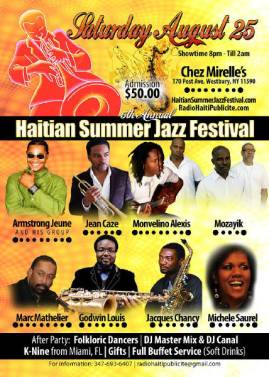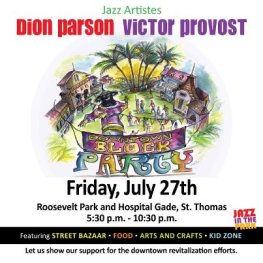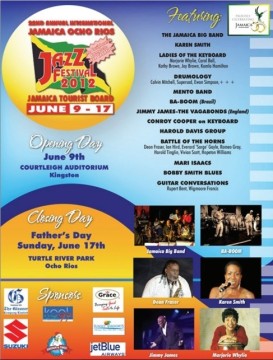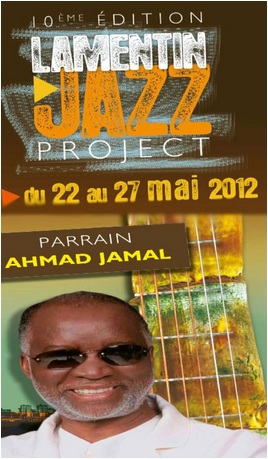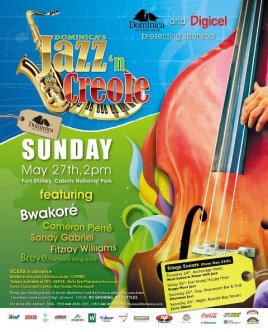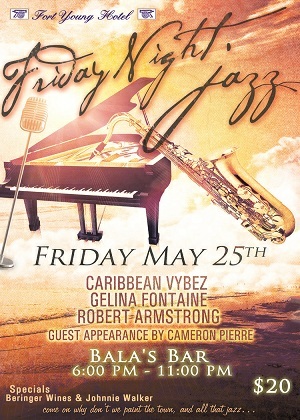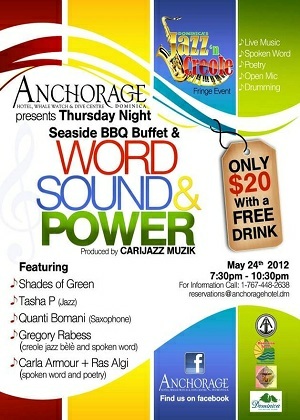Sugar Isle Jazz Festival: A rare fest in Barbados this June
June 9, 2012 Leave a comment

BARBADOS
One year ago this January when the Barbados Jazz Festival faltered unceremoniously and petered out, it seemed as though Barbados was heading into a Jazz festival recession. Since then, some moderate Jazz events were added to the island’s calendar thus serving as a boost to the outings of working Jazz musicians at various local establishments on Barbados.
Tom Hinds has amped up the scene with Art & Jazz on Sunday afternoons at the scenic Naniki Amphitheatre, with invites going out to attractive international and Caribbean Jazz acts like Raf Robertson, Annise Hadeed, Dougie Redon, Richard Bailey, Theron Shaw and Luther François as complements to Barbados’ home-grown talents, Rhea Drakes, Arturo Tappin, Roger Gittens, Stefan Walcott and Kellie Cadogan.
Now musician and promoter Deryck Walcott who conceptualised Christmas Jazz has added another layer unto the Barbados landscape with a Jazz festival in June. Walcott produced the inaugural Sugar Isle Jazz Festival at various venues on the first weekend of June. Performances were held at the Frank Collymore Hall, Plantation Garden Theatre and the Garfield Sobers Stadium. Sugar Isle Jazz Fest had on tap an exciting line-up of some of the best in Barbados, from around the Caribbean region and further afield.
To start off, on Friday, June 01, Haitian songstress Pauline Jean and Cuban pianist Elio Villafranca came in from the United States, their musical home base, to play the Swing Night under the Jaleel Shaw Quintet at the Frank Collymore Hall in the heart of the capital, Bridgetown. The Nation News of Barbados sent out a reporter to cover the show. Natanga Smith Hurdle christened it thus:
JAZZ WITH LOTS OF SUGAR by Natanga Smith Hurdle, NATIONNEWS.COM | Sun, June 03, 2012 – 12:04 amAlto saxophonist Jaleel Shaw blew the audience away when he closed the show on the opening night Friday of the CIBC FirstCaribbean Sugar Isle Jazz Festival. But the evening got off to a swinging start with the Haitian American Pauline Jean.
Jean’s presence, as well as her voice, is going to capture you from the first note. Beautiful and powerful, it has been compared to those of Cassandra Wilson, Nina Simone and Sarah [Vaughan]…. But there’s a difference in Pauline’s music; being of Haitian descent, she sings in English, French and Creole. And with her first song she transformed Frank Collymore Hall into a dusky, smoky room somewhere down in Louisiana, Baton Rouge.
There’s no doubt Pauline and her band can swing. While she allowed her songs to thrill, the band’s individual arrangements with Elio Villafranca on piano, Shirazette Tinnin on drums…and Johnathan Michele on bass went back and forth from funky to traditional jazz.
If Pauline is good…swinging…she is even better singing ballads, with lovely and soulful renditions of Haitian folkore, featuring Wongolo which she says is near and dear to her heart. In this song, in her native tongue, you could hear the passion, power and pride in her voice.
Her bubbliest best
…. Also with Panama M’ Tombe, a satire about a Haitian politician and his hat, she was at her bubbliest best, engaging and energetic, dancing around the stage, taking you on an emotional ride. Each rendition was met with enthusiastic applause….
On Saturday, June 02, The Plantation Garden Theatre came alive with the Caribbean Jazz of The Golden Apple Project, mentored by the saxiest of them all, Barbabian saxophonist Arturo Tappin. GAP’s personnel for this Caribbean Night was Rhesa Garnes on vocals along with David Carnegie (drums), Darien Bailey (keyboards), Romaro Greaves (sax) and Neil Newton (bass). The Golden Apple Project, was introduced to the Caribbean Jazz stage during this year’s Tobago Jazz Experience by Tappin.
The GAP opened Caribbean Night for an all-star Caribbean band featuring Trinidadian pannist Len “Boogsie” Sharpe, Barbadian sax man Elan Trotman, Vincentian keyboardist Frankie McIntosh, Trinidadian bassist Ron Reid, Jamaican guitarist Maurice Gordon plus an Antiguan drummer, Rico Anthony. The all-stars closed out the show with their Jazz interpretations of some of the biggest hits from Lord Kitchener, Mighty Sparrow and Bob Marley, David Rudder, Edwin Yearwood and Alison Hinds.
HAND IT TO THE BANDS by Natanga Smith Hurdle, NATIONNEWS.COM | Tues., June 05, 2012 – 12:05 amIN BAJAN PARLANCE, the two bands do “bad, bad, bad” Saturday night at the CIBC FirstCaribbean Bank Sugar Isle Jazz Festival at The Plantation Theatre on Caribbean Night.
The Caribbean was represented by the Golden Apple Project, the local [Barbadian] band, and the Caribbean All-Star Band, which included Trinidadian Len “Boogsie” Sharpe on steel pan. Earning an encore and standing ovation each [of] the two bands brought their own style, sound and concept to the stage.
First up was Golden Apple Project with David Carnegie on drums, Neil Newton on bass; Rhesa Garnes with vocals, Romaro Greaves on saxophone and Darien Bailey on keyboards. They had a tremendous set, switching from jazz to soca to reggae to ballads….
They deserved the standing ovation for the jazz rendition of the Carnival hit Bacchanalist.
Elan Trotman. Elan Trotman. Elan Trotman. Not only is his music easy on the ears, he is also easy on the eyes. He was included in the Caribbean All Star Band, put together four days before the event, along with “Boogsie”, Frankie McIntosh from St Vincent on keyboards, Maurice Gordon from Jamaica on guitar, local lads Wayne Poonka Willock and James Lovell on percussion, Rico Anthony from Antigua on drums and Trinidadian Ron Reid on bass, who rounded out a fabulous octet….
Trotman squeezed every note out of the tenor sax and titillated with the soprano sax. Dipping and shaking as he brought out each warble with the latter, he held a note so long it took your breath away. “Sweeeeeet” said two different audience members simultaneously.
Gordon produced memorable moments, finding a gimmick or two to add drama. The theme of the band was cooperation and when “Boogsie” came on stage to rapturous applause, he added a different element to the band. He had those steel pans rocking in their stands. Poonka and Lovell combined to do baaaadd on the drums, playing congas and timbales, respectively.
Trotman stole the spotlight in the last song Just The Two Of Us, sometimes layering over the beat, other times floating all over it and checking in just enough to bring things back to the stage, even when he went into the audience. Standing ovation.
The band played Could This Be Love and indeed it was. Kudos to both bands for cohesive ensemble performances. And what a display of music it was.
Speaking to WayneG of The All Caribbean Jazz Show on BlogTalk Radio, Cheryl Holder, Secretary of the Barbados Jazz Society, lamented that the Swing Night was not very well attended due to a clash with a major political event taking place in Barbados at the same time. However, according to Holder, the Caribbean Night featuring Pauline Jean and her band, which had Elio Villafranca in its ranks, brought the people out in their numbers. Singing in Creole and English, Jean’s performance was enthralling, if I am to put words in Holder’s mouth. Holder also noted that International Night, because it was not quite Jazz, attracted a fine general crowd.
To climax the inaugural Sugar Isle Jazz Festival, a hand-picked band of star-studded names like Grammy award-winning guitarist/vocalist Jonathan Butler and American smooth jazz saxophonist Mindi Abair paid tribute to one of the greatest R&B and pop artistes of all time, Stevie Wonder, on International Night, June 3 at Kensington Oval, a sports stadium transformed into a theatre for the night. Gospel a capella group Take 6 opened that show.













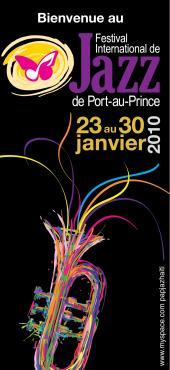
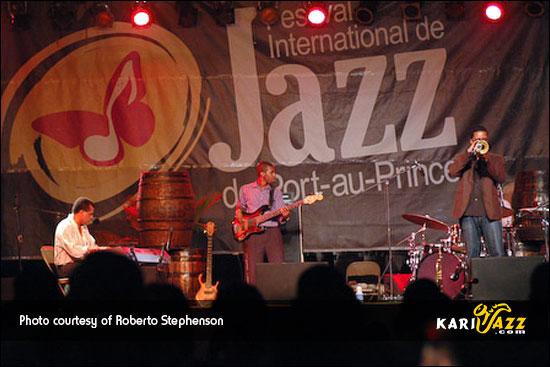











 Santos, Sosa
Santos, Sosa Villafranca
Villafranca
